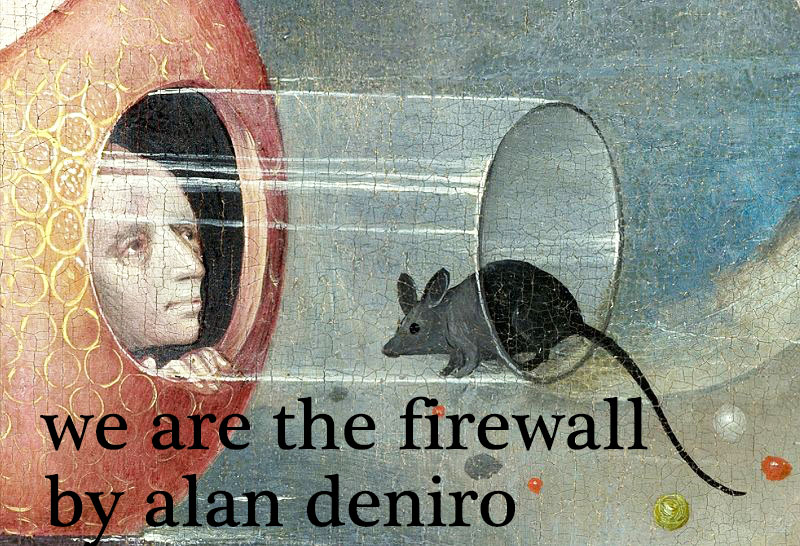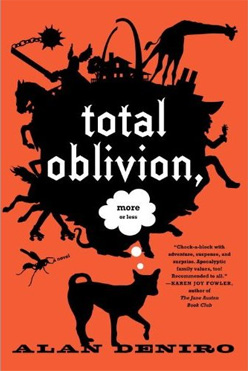We Are the Firewall released + design notes
I’ve released a “game-novella” that I made in Twine called We Are the Firewall. It’s set in a dystopian near-future Minneapolis (and the Republic of Georgia) and has about a dozen interwoven point-of-view characters. It’s definitely of a piece thematically and style-wise to many of the stories forthcoming in my new collection Tyrannia, and the point-and-click aspects of the gameplay allowed me to dive deeper into a setting in a much different way than with “static” fiction.

(Very vague spoilers ahead)
For one thing, it should be noted that this is not “Choose Your Own Adventure” (or CYOA). There’s no way to affect the outcome of the story; only in how you experience it in following the various paths of the story. I had been struck a few months ago by a comment that Emily Short had made on her blog (which I tried to find but couldn’t! Well, I hope I’m not misremembering it too badly) that interactive fiction doesn’t have to be choice based fiction-that the two often get confused (or let’s say intertwined in interesting or not so interesting ways). Deadline Enchanter also played with this idea of choice, though much more linearly, and more on the side of “player complicity” (since the game is mimicking an “implementation” within the game world).
We Are the Firewall definitely isn’t linear! But its non-linearity is at the service of narrative. That at least is the guiding principle. I have had the idea of telling a story something like this for awhile, with a big cast of characters set in Minneapolis, and some of the passages (heavily edited in most cases) are years old from an abandoned novel project. The often-recurring “framing” passage, for lack of a better term-the (Fire)Wall of Adjectives-is one of these passages of text.
Aside from Twine itself, I wouldn’t have been able to tell the story the way I wanted it too without many of the macros created by Leon Arnott. The click-throughs to replace text, and the timed replacement, disappearance, and insertion of blocks of text allowed We Are the Firewall to have the textured quality I was looking for.
For sure, having lots of blocks of text appearing and disappearing with little or no volition on account of the player was something I debated throughout the creation of the piece. But the reason I left that mechanism in was that, in order to tell this story, I wanted to create an experience of interacting with this world that paralleled living in this world.
Because this is a near-future world of stratification and distraction. People from different social classes rarely interact with each other; half of the city (Nordeast) is walled off, drones are controlled in anonymous warehouses (or one can have a “working vacation” and help control a drone while fishing up north), and the only place while acts as a “village green” is the educational first person shooter Math Frag.
More than that, though-aside from these physical and virtual barriers, this is a world in which people really aren’t paying attention to each other, even people they care about. The information overload is much more complete (though also breaking down according to class lines: the ultra-wealthy have implants directly into the eye, the upper middle and “aspirational” classes have “smart” glasses or goggles and the rest have, well, phones). So this is a text medium in which the characters are overloaded by text. Mimetic fallacy? Well, sure, but so be it. To be sure, there’s a tension there between “just telling the story” and creating blockages in the story that replicate how the characters navigate their world. To put it another way: I remember ten years ago how I would be startled at someone wearing a Bluetooth headset barking orders to it, or have a conversation with, seemingly, no one. That has become really normalized for me, but if I think about it, it really is a peculiar phenomenon. We have become adept at filtering out the “noise” from other people. Sometimes scarily so.
So essentially what I tried to do was the extrapolate out the acceleration of this “noise”, particularly as they would often take textual and not merely aural forms (from the bombardment of text from eye implants or smart glasses). Junk forms (a lot of the most-rapidly disappearing pieces of text I lifted and remolded from random Google Groups searches of long-abandoned discussion threads). In that sense, this is nothing new-a lot of the best “social” science fiction from the 50s onwards utilized this effect. I’m thinking off the top of my head Gateway by Fredrick Pohl, which was set on a hyper-commercialized hollowed-out asteroid. And, heck, go back farther to the origins of the novel itself, which often took epistolatory, “found object” forms. But that is probably worth another post. Anyway, the ability to texture the narrative this way gave me access to an extra set of tools dealing with time itself. I should say as well that my hope is that the Wall of Adjectives would be able to be approached and read across multiple playthroughs, and there are screens later on of it that are more or less static.
Whether it works or not is up to the reader/player, but I hoped to create an accretive, accumulating effect by having to go back into the narrative over and over, plumbing different perspectives until they would combine into something of a whole. An imperfect whole but a whole. So the narrative is one of stitching-together rather than breaking apart-and that stitching is the “game” part of game-novella. In that sense, despite how depressing a lot of it is, I wanted the bringing together of different characters-ones who may or may not have encountered each other before, or in a completely different setting-and at least create the possibility of people in this stratified society to meet and break bread (or have a drink or song) together. To make interacting with the characters a way to not only move the story forward, but to have them gain strength from each other. There is a very specific trio of characters in We Are the Firewall that are coaxing this outcome out as well, and they too have their own stories.
I tried to create variety in what types of interactions were on each page. Some were only text; some had only timed events; some I considered a kind of a cyberpunk advent calendar. And some had combinations of each effect. The intersection of the individual page and the individual character. For someone like Harlan, a drug-addicted musician who thinks he is much more revolutionary than he actually is, clicking through his cliches reveals the hidden contexts of his vagueness. For someone like Rosaria, a former soldier dealing with both cancer and PTSD (in the midst of a failing vet health care system), clicking through her memories of firefights keeps going deeper and deeper, into layers and layers of hell. And so on. As usually happens, some characters surprised me about how insistent they wanted their stories told; people who I considered natural villains revealed strengths or vulnerabilities that I hadn’t even fathomed. The Twine medium let me adjust this on the fly. It really is a fantastic storytelling tool, and it is literally getting better every month, as more people build in more functionality. The breadth of stories and games made with it just over the last year is truly astounding.
If you have any interest in leaving a tip for the game, please consider donating to Mercy Corps’ efforts to help Syrian refugees.





